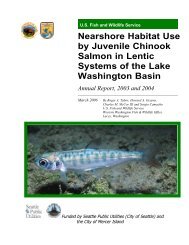2005 State of Mobility Report - City of Bellevue
2005 State of Mobility Report - City of Bellevue
2005 State of Mobility Report - City of Bellevue
You also want an ePaper? Increase the reach of your titles
YUMPU automatically turns print PDFs into web optimized ePapers that Google loves.
Glossary<br />
85th Percentile Speed<br />
A measure <strong>of</strong> vehicle speed along a roadway<br />
segment; 85 percent <strong>of</strong> the vehicles are traveling at<br />
or below this stated speed. (Chapter 6)<br />
Accident Rates<br />
Used to evaluate the number <strong>of</strong> accidents at<br />
an intersection or along a roadway segment to<br />
the number <strong>of</strong> vehicles traveling through the<br />
facility. Rates from different locations can then<br />
be compared to determine the highest accident<br />
sites. The intersection accident rate is the number<br />
<strong>of</strong> accidents per million vehicles entering the<br />
intersection. The mid-block corridor rate is the<br />
number <strong>of</strong> accidents occurring along a roadway<br />
segment per million vehicle miles traveled in the<br />
corridor. (Chapter 7)<br />
Accident Reduction Program<br />
A program that identifies traffic accident reduction<br />
projects to address hazardous conditions and reduce<br />
the high cost <strong>of</strong> traffic accidents to the traveling<br />
public. (Chapter 7)<br />
Americans with Disabilities Act (ADA)<br />
1990 federal law to prohibit discrimination against<br />
people with disabilities in all aspects <strong>of</strong> life,<br />
including the provision <strong>of</strong> transportation facilities<br />
and services. (Chapter 7)<br />
Bicycle Facilities<br />
A general term referring to improvements that<br />
accommodate or encourage bicycling. Bicycle lanes<br />
are typically installed on two sides <strong>of</strong> a roadway,<br />
while a bicycle path typically runs along only one<br />
side <strong>of</strong> the road. (Chapter 11)<br />
Bicycle Level <strong>of</strong> Service (BLOS)<br />
A method <strong>of</strong> evaluating and quantifying the<br />
perception <strong>of</strong> a bicyclist’s comfort and safety.<br />
(Chapter 11)<br />
Budget Available<br />
Total budget available for expenditure; combines<br />
adopted budget for the year with unspent funds<br />
from the previous budget year. (Chapter 5)<br />
Budget Survey<br />
Biennial telephone survey <strong>of</strong> a sample <strong>of</strong> <strong>Bellevue</strong><br />
residents to understand community priorities and<br />
perceptions about <strong>City</strong> services and programs.<br />
(Chapters 2 and 6)<br />
Bus Rapid Transit (BRT)<br />
Bus operation that is generally characterized as<br />
running on exclusive or reserved rights <strong>of</strong> way in<br />
order to maintain higher speeds along the route<br />
than if operated within HOV or general purpose<br />
lanes. (Chapters 2 and 9)<br />
Capital Investment Program (CIP)<br />
<strong>Bellevue</strong>’s seven-year strategic plan for implementing<br />
the Comprehensive Plan Capital Facilities Element<br />
policies and project recommendations from other<br />
functional plans. The CIP is the major planning<br />
tool <strong>of</strong> the <strong>City</strong> in which needed improvements to<br />
the city’s facilities and infrastructure are identified,<br />
prioritized, priced, and discussed with the <strong>City</strong><br />
Council and public. Funding from a variety <strong>of</strong><br />
sources, including local taxes, is matched with the<br />
costs <strong>of</strong> these projects. After the <strong>City</strong> Council has<br />
reviewed and approved the program, these projects<br />
are implemented. The CIP is updated every two<br />
years. (Primarily Chapters 4 and 5)<br />
Carry Forward<br />
Funds unspent at the end <strong>of</strong> a budget year that are<br />
transferred to the next year’s budget. (Chapters 4<br />
and 5)<br />
Channelization<br />
Roadway striping and signage to guide motorists,<br />
bicyclists, and other users <strong>of</strong> the roadways.<br />
(Chapters 5 and 7)<br />
Community<br />
The combined interest <strong>of</strong> the <strong>City</strong>, its residents,<br />
commercial entities, and other local parties that<br />
may be affected by <strong>City</strong> actions.<br />
118<br />
<strong>2005</strong> <strong>State</strong> <strong>of</strong> <strong>Mobility</strong> <strong>Report</strong>

















